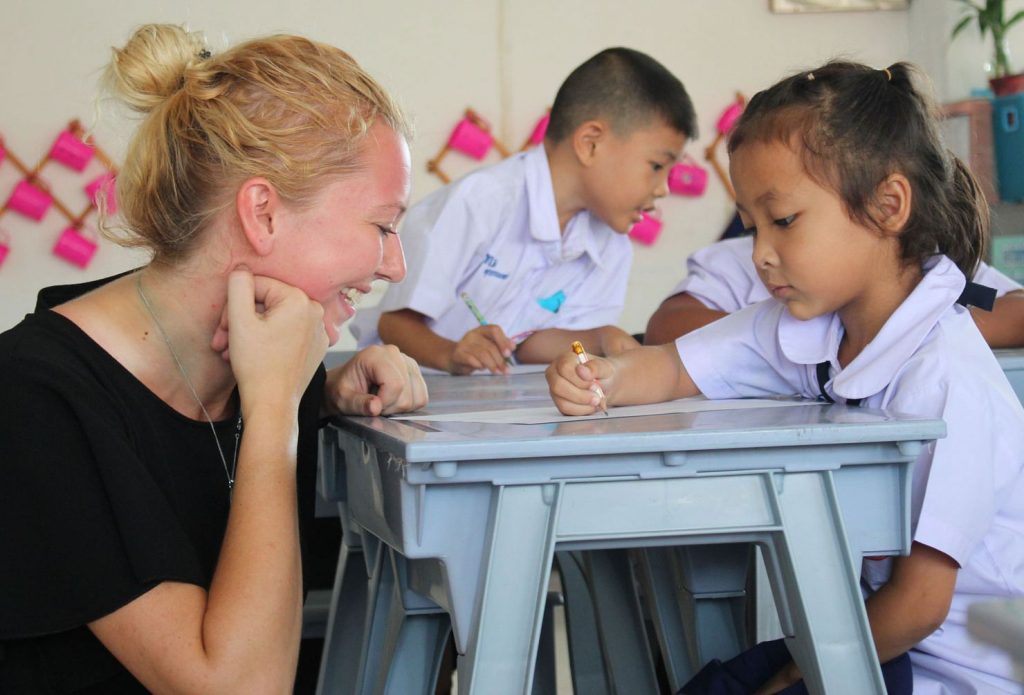Preschoolers and kindergarteners might not seem like the most absorbent learners on the planet, but a TEFL teacher that specializes in teaching young learners needs to be way on top of their game.
Walking into a classroom full of 25 rambunctious kiddos is a wild adventure, full of rewards and challenges. Are you prepared? Here are our five essential tips for first-time TEFL teachers entering the early learners classroom.

5 tips for teaching young learners English
1. Have the energy
Moving abroad will reveal a multitude of distractions to take your time and energy. You’ll want to stay out late dancing, have chuanr after midnight with your new buds, spend time FaceTiming family back home at odd hours (sometimes even the very early AM!). You’ll want to gallivant on weekends to the coast or jetset to a neighboring country.
The adventure is a huge advantage of teaching abroad, but you must keep in mind that you’re there to work, too. And that means saving some of your precious energy reserves for your classroom. Never is that more than when you’re working with kindergarteners and preschoolers.
Young learners will reflect your attitude and excitement, so bring your A game. On the bright side, they’re very easily entertained! Make your classroom fun and interesting and your kiddos will give you their best back.

2. Routines are essential
Your little learners benefit greatly from routines in the classroom, so it is essential that you establish these norms early on in your TEFL career. It can take some up-front work, but will set your classroom up for success—if there’s a predetermined activity for every part of the day, you can put more of your energy towards teaching. You won’t need to focus on generally controlling the class as much.
Furthermore, this provides a healthy environment for your students to grow, learn, explore, and… practice English! It helps students learn that you’re a caring adult who will provide what they need.

When they feel safe, kids can stay more calm. Overall, routines are great for a child’s emotional, cognitive, and social development, and you’ll benefit as that calm, cool, collected teacher whose classroom always (okay, sometimes!) maintains order. These are 3-6 year olds, after all!!!
3. Focus on positive behavior
Young English learners gain respect through interaction with caring adults who show them respect and value their individual personalities. It is important that you, as their TEFL teacher, reinforce positive behaviors and provide simple instructions in the positive rather than negative (i.e. “Please shut the classroom door” is better than “Don’t leave the classroom door open”).
These clear tasks let your students know what’s expected of them, and your recognition of good behavior increases the likelihood that the behavior will be repeated.

Highlighting their positive deeds and qualities can increase enthusiasm from your students and provide a stimulating, inviting learning environment. Be sure to incorporate effort-based praise, too, which focuses more on what kids can control, like how much time they spend on a project. Avoid personal praise on natural abilities, like intelligence or a talent for playing the piano (which can hinder growth).
4. Be consistent as a disciplinarian
I know they all look like angels at first, but you’re eventually going to need to have a stern talk with Little Timmy about his behavior. Your goal should be to be consistent in how you administer discipline.
Of course, no one can be 100% consistent 100% of the time, but the effort outweighs the outcome of when you’re frequently inconsistent (you’ll likely end up more tired, cranky, impatient, and worn out!).

Establish some classroom rules (bonus points if you get student input!) and provide structure for your classroom (AKA tip #2). Have a plan for when negative consequences need to be administered for misbehavior. Communicate your expectations not only to the students, but to other teachers in your classroom as well.
Follow through with these consequences and resist the urge to “give in” (lest you go mad in the long run!). Most importantly, have patience with yourself and your kiddos—change doesn’t happen overnight, so don’t give up on your discipline techniques early!
5. Build YOUR understanding of how early learners learn
Kids are basically tiny little sponges at this stage of life. They’re growing in myriad ways—not just taller and wider (with bigger feet), but also—and more importantly—socially, emotionally, physically, and linguistically.

This means there’s a lot of input being thrown at a child, and they often need a lot of diverse activities to stay engaged in the classroom. This means that you, as a teacher, should focus less on extended lessons and explanations and more on age-appropriate games and interactive activities.
Pro tip: You’ll likely have to make it up as you go, so don’t get too attached to a certain activity or outcome. Adapt!
Teaching young learners is an adventure
Yes, there will be cryers. There will be kiddos crawling under (and on) their desks and throwing paper balls. I can even picture an obstinate little fella who won’t do ANYTHING. Hopefully these ideas will put you on the right track to deal with this unique group of English learners, and make your classroom a fun, stimulating learning environment for students and teacher alike!
The post How Do You Teach Young Learners English? appeared first on Premier TEFL.


